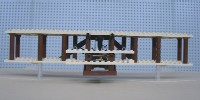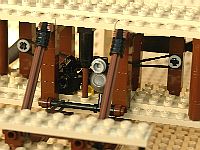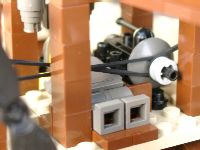 |
My Own Creations
Wright 1903 Flyer |
 |
|
 |
 |
 |
|
 |
My Own Creations
Wright 1903 Flyer |
 |
|
 |
 |
 |
|
|
A hundred years ago on December 17th the Wright brothers
made the first sustained controlled flight with a powered heavier-than-air
flying machine. It took place on the flat sandy beach at Kitty Hawk in
North Carolina which offered privacy and strong steady winds. Orville and
Wilbur made four flights alternating as pilot with the last flight covering
no less than 260 meters (852 feet) in 59 seconds. After this a gust overturned
the Flyer and it has never flown again. The Flyer was crated and shipped
back to Dayton where it was put in storage in a shed behind the bicycle
shop. From 1916 it was exhibited several times before going to the Science
Museum in London in 1928. Since December 17th 1948 it has been on display
at the Smithsonian
National Air and Space Museum where you can read more
about the Flyer.
The Flyer was an enlarged development of the Gliders the brothers had flown in the preceding years. The Flyer was a revolutionary design introducing several new features like propellors and using control surfaces and wing warping for in-flight control. |
|||||||||||||
|
|
||||||||||||||
 |
Front view
Showing the general layout. |
|||||||||||||
 |
Front close up
Next to one of the Wright brothers is the small engine. And in front of him is the lever for the control surfaces. Just above his head is the odometer. |
|||||||||||||
 |
Rear close up
Note that the left rubber band is twisted. That way the propellors counterrotates. In the top left corner is the gasoline tank. |
|||||||||||||
 |
Top close up
Showing how close the pilot is to the engine. It must have been hot because the main problem with the engine was over-heating. |
|||||||||||||
 |
Bottom close up
You can see how the tubes/straws are attached and that the lower rear riggers are wider than the top rear riggers. |
|||||||||||||
|
|
||||||||||||||
| Blueprint | Technical Specifications | |||||||||||||
 |
|
|||||||||||||